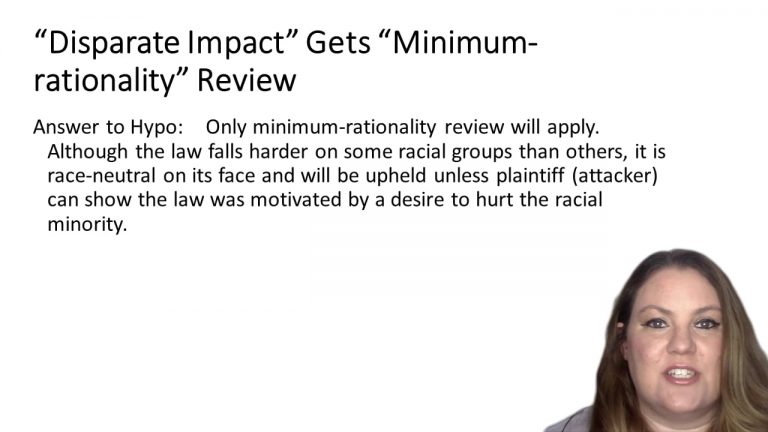SmartBrief
Confirm favorite deletion?
Constitutional Law Keyed to Choper
Washington v. Davis
Citation:
426 U.S. 229, 96 S.Ct. 2040, 48 L.Ed.2d 597 (1976).Facts
To become a police officer in the District of Columbia, a police recruit is required to satisfy certain physical and character standards, to be a high school graduate or its equivalent, and to receive a grade of at least 40 out of 80 on “Test 21,” an examination that is used generally throughout the federal service which was developed by the Civil Service Commission and which was designed to test verbal ability, vocabulary, reading, and comprehension.
The evidence showed that roughly 4x as many blacks as whites failed Test 21. Apart from the test, however, the Police Department had systematically and affirmatively sought to enroll black officers. As a result, 44% of new police force recruits had been black in the years preceding this case.
Plaintiffs argue that Test 21 has a substantially discriminatory impact and could not be used unless the Police Department could show that it bears a substantial and demonstrated relationship to performance on the job.
Only StudyBuddy Pro offers the complete Case Brief Anatomy*
Access the most important case brief elements for optimal case understanding.
*Case Brief Anatomy includes: Brief Prologue, Complete Case Brief, Brief Epilogue
- The Brief Prologue provides necessary case brief introductory information and includes:
Topic:
Identifies the topic of law and where this case fits within your course outline.Parties:
Identifies the cast of characters involved in the case.Procedural Posture & History:
Shares the case history with how lower courts have ruled on the matter.Case Key Terms, Acts, Doctrines, etc.:
A case specific Legal Term Dictionary.Case Doctrines, Acts, Statutes, Amendments and Treatises:
Identifies and Defines Legal Authority used in this case.
- The Case Brief is the complete case summarized and authored in the traditional Law School I.R.A.C. format. The Pro case brief includes:
Brief Facts:
A Synopsis of the Facts of the case.Rule of Law:
Identifies the Legal Principle the Court used in deciding the case.Facts:
What are the factual circumstances that gave rise to the civil or criminal case? What is the relationship of the Parties that are involved in the case.Issue(s):
Lists the Questions of Law that are raised by the Facts of the case.Holding:
Shares the Court's answer to the legal questions raised in the issue.Concurring / Dissenting Opinions:
Includes valuable concurring or dissenting opinions and their key points.Reasoning and Analysis:
Identifies the chain of argument(s) which led the judges to rule as they did.
- The Brief Prologue closes the case brief with important forward-looking discussion and includes:
Policy:
Identifies the Policy if any that has been established by the case.Court Direction:
Shares where the Court went from here for this case.
Topic Resources
Topic Outline
Topic Refresher Course

 5m 39s
5m 39s